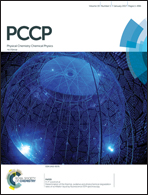A heat capacity model of T3/2 dependence for quantum dots†
Abstract
This article addresses the heat capacity of quantum dots (QDs) using density functional theory (DFT). By analyzing the evolution of phonon density of states and heat capacity as CdSe clusters grow from a molecular cluster into larger quantum confined solids, we have shown that their heat capacity does not fit very well with the Debye T3 model. We observed that the number of phonon modes, which is discrete, increases as the particles grow, and the dispersion relation shows a quadratic behavior in contrast to the bulk solids whose dispersion relation is linear and equal to the sound velocity. The phonon density of states showed a square root variation with respect to frequency whereas that of the bulk is a quadratic variation of frequency. From the observed variation in the phonon density of states and holding the fact that the atomic vibrations in solids are elastically coupled, we have re-derived the expression for total energy of the QDs and arrive at a T3/2 model of heat capacity, which fits very well to the observed heat capacity data. These results give promising directions in the understanding of the evolution of the thermophysical properties of solids.



 Please wait while we load your content...
Please wait while we load your content...